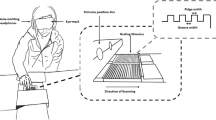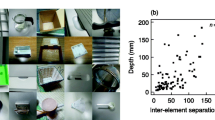Summary
Human subjects were required to differentiate grating surfaces of alternating grooves and ridges by moving a finger back and forth across the surface. Their discriminative capacities were measured, as well as the movement and force profiles that they selected. To measure discrimination, a forced choice paradigm was used in which three surfaces were presented on each trial. Two surfaces were the same (standards) and the subject was required to indicate which of the three surfaces (the comparison) differed from the other two. Two series of surfaces were used with standards whose spatial periods were 770 and 1002 μ, respectively. Subjects were able to discriminate, at the 75% correct level, two gratings which differed in spatial period by the order of 5%. When tangential movement between the surface and the finger was eliminated, and only radial contact permitted, discrimination was degraded and the 75% correct levels increased to the order of 10%. Subjects were free to choose their own patterns of finger movement and of contact force between finger and surface. Movement was measured cinematographically. For all subjects movement patterns were close to sinusoidal, with frequencies in the range of 4.0 Hz and with mean velocities of the order of 160 mm/s. Patterns of contact force were measured by a force transducer. For all subjects the force varied rhythmically in synchrony with movement, but the patterns and magnitudes varied with the subject. Gratings were scaled for perceived roughness by a magnitude estimation technique: the relationship between perceived roughness and grating period was monotonic.
Similar content being viewed by others
References
Amerine MA, Pangborn RM, Roessler EB (1965) Principles of sensory evaluation of food. Academic Press, New York
Bauer HJ (1952) Discrimination of tactual stimuli. J Exp Psychol 44: 455–459
Binns H (1937) Visual and tectual ‘judgement’ as illustrated in a practical experiment. Br J Psychol 27: 404–410
Braddick O (1981) Spatial frequency analysis in vision. Nature 291: 9–11
Cronin V (1977) Active and passive touch at four age levels. Dev Psychol 13: 253–256
Culbert SS, Stellwagen WT (1963) Tactual discrimination of textures. Percept Mot Skills 16: 545–552
Darian-Smith I, Oke LE (1980) Peripheral neural representation of the spatial frequency of a grating moving across the monkey's fingerpad. J Physiol (Lond) 309: 117–133
DeValois RL, Jacobs GH (1968) Primate color vision. Science 62: 533–540
Ekman G, Hosman J, Lindström B (1965) Roughness, smoothness, and preference: A study of quantitative relations in individual subjects. J Exp Psychol 70: 18–26
Gellis M, Pool R (1977) Two-point discrimination distances in the normal hand and forearm. Plast Reconstr Surg 59: 57–63
Gibson JJ (1962) Observations on active touch. Psychol Rev 69: 477–491
Gliner CR (1967) Tactual discrimination thresholds for shape and texture in young children. J Exp Child Psychol 5: 536–547
Gridgeman NT (1964) Sensory comparisons: The 2-stage triangle test with sample variability. J Food Sci 29: 112–117
Grunwald AP (1966) A Braille-reading machine. Science 154: 144–146
Hopkins JW, Gridgeman NT (1955) Comparative sensitivity of pair and triad flavour intensity difference tests. Biometrics 11: 63–68
Johnson KO, Darian-Smith I, LaMotte C, Johnson B, Oldfield S (1979) Coding of incremental changes in skin temperature by a population of warm fibers in the monkey: correlation with intensity discrimination in man. J Neurophysiol 42: 1332–1353
Katz D (1925) Der Aufbau der Tastwelt. Zeitschrift für Psychologie. Ergänzungsband 11
Krueger LE (1970) David Katz's Der Aufbau der Tastwelt (The world of touch): A synopsis. Percept Psychophys 7: 337–341
Lamb GD (1982) Tactile discrimination of textured surfaces: psychophysical performance measurements in humans. J Physiol (Lond) (in press)
Lederman SJ (1974) Tactile roughness of grooved surfaces: The touching process and effects of macro- and microsurface structure. Percept Psychophys 16: 385–389
Lederman SJ (1978) “Improving one's touch”... and more. Percept Psychophys 24: 154–160
Lederman SJ, Taylor MM (1972) Fingertip force, surface geometry, and the perception of roughness by active touch. Percept Psychophys 12: 401–408
McNicol D (1972) A primer of signal detection theory. Alien and Unwin, Sydney
Meenes M, Zigler MJ (1923) An experimental study of the perceptions of roughness and smoothness. Am J Psychol 34: 542–549
Schwartz AS, Perey AJ, Azulay A (1975) Further analysis of active and passive touch in pattern discrimination. Bull Psychonomic Soc 6: 7–9
Stevens SS, Harris JR (1962) The scaling of subjective roughness and smoothness. J Exp Psychol 64: 489–494
Author information
Authors and Affiliations
Additional information
Supported by a grant from the National Health and Medical Research Council of Australia
Rights and permissions
About this article
Cite this article
Morley, J.W., Goodwin, A.W. & Darian-Smith, I. Tactile discrimination of gratings. Exp Brain Res 49, 291–299 (1983). https://doi.org/10.1007/BF00238588
Received:
Issue Date:
DOI: https://doi.org/10.1007/BF00238588




